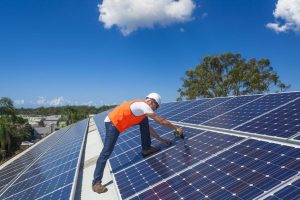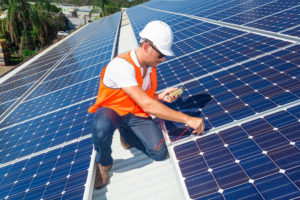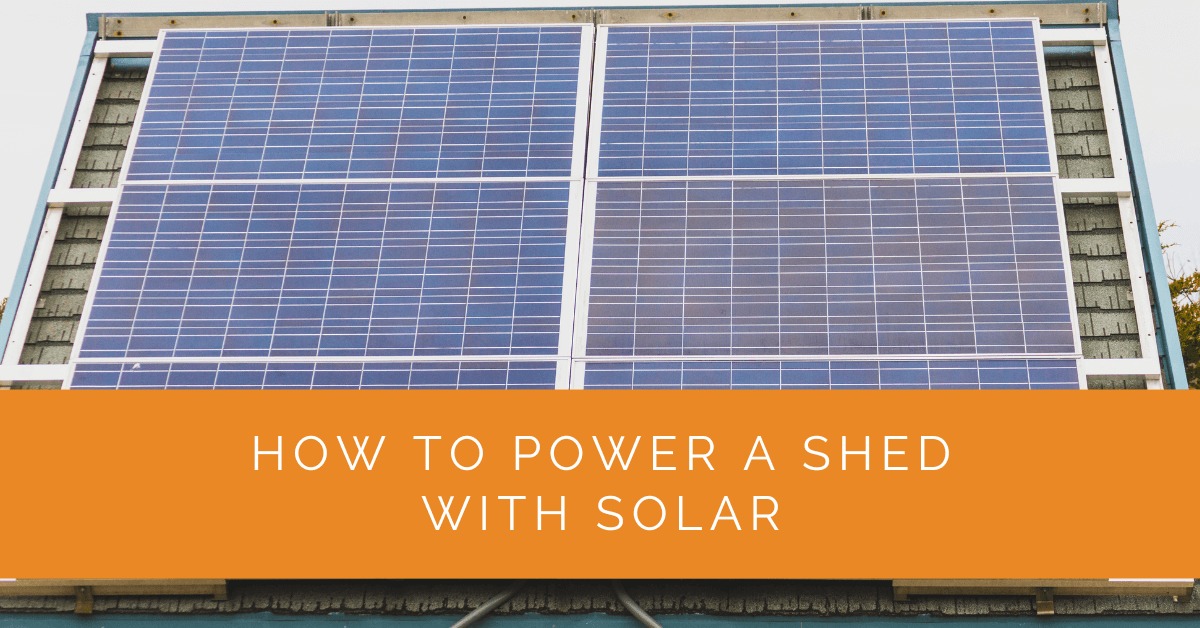Solar power has gained immense popularity recently, offering an eco-friendly and cost-effective solution for powering various applications. One such application is powering sheds with solar energy. This comprehensive guide will delve into how to efficiently power your shed using solar panels, reducing your reliance on traditional electricity sources and lowering your electricity bills.
Contents
- 1 Key Takeaways
- 2 Assessing Your Power Needs
- 3 Choosing the Right Solar Panel System
- 4 Installation Process
- 5 Maximizing Solar Power Efficiency
- 6 Cost Considerations
- 7 Expanding Your Solar Power System
- 8 Powering a Shed with Solar for Various Applications
- 9 Considerations for the Solar System
- 10 Case Study: Transforming a Shed into a Solar-Powered Workspace
- 11 Expert Insights From Our Solar Panel Installers About Powering a Shed with Solar
- 12 Experience Solar Excellence with Us!
- 13 Conclusion
Key Takeaways
- Assess your shed’s power needs and choose the right solar panel system to efficiently power your shed with solar energy, considering factors such as available space and compatibility with your electrical setup.
- Maximize solar power efficiency by positioning panels for optimal sunlight exposure, utilizing energy storage solutions, and ensuring regular monitoring and maintenance of your solar power system.
- Consider various shed applications such as home offices, storage spaces, or recreational areas, and tailor your solar power system to meet the specific power requirements of each scenario.
Assessing Your Power Needs
Before diving into the installation process, assessing your shed’s power requirements is crucial. Consider the appliances and equipment you intend to power and determine their energy consumption. This step will help you gauge the power needed from your solar system. Additionally, remember that the power needs of a shed serving as a simple storage space will differ from those used as a home office or workshop.
Choosing the Right Solar Panel System
To ensure optimal performance, selecting the right solar panel system is essential. Numerous options are available, ranging from standalone solar panels to complete solar panel kits designed specifically for sheds. When choosing, consider factors such as the available space on your shed’s roof, the desired power output, and the system’s compatibility with your shed’s electrical setup.
Installation Process
Preparing Your Shed
Before installing solar panels, prepare your shed to accommodate the system. Ensure the roof or the area where you plan to install the panels is structurally sound and capable of supporting the added weight. Inspect the roof for any damage and make necessary repairs. Additionally, clear the area surrounding your shed to maximize sunlight exposure.
Mounting the Solar Panels
Once your shed is ready, it’s time to mount the solar panels. Depending on your shed’s design and available space, you can choose between roof-mounted or ground-mounted systems. Roof-mounted panels are a popular choice as they utilize existing space efficiently. However, ground-mounted panels may be a better option if your shed roof doesn’t receive sufficient sunlight.
Wiring and Connection
To effectively harness solar power, proper wiring, and connection are crucial. Install a charge controller, which regulates the voltage and current flowing between the solar panels and the battery bank. This device protects your batteries from overcharging and ensures optimal performance. Additionally, connect an inverter to convert the direct current (DC) produced by the solar panels into alternating current (AC) that can power your shed’s appliances.

Maximizing Solar Power Efficiency
To make the most of your solar power system, consider the following tips for maximizing efficiency:
- Optimal Positioning: Position your solar panels to receive maximum sunlight throughout the day. Orient them towards the sun’s path and avoid shading from nearby trees or buildings.
- Energy Storage Solutions: Incorporate a battery bank to store excess energy your solar panels produce. This allows you to utilize solar power even during periods of low sunlight.
- Monitoring and Maintenance: Regularly monitor the performance of your solar power system and ensure proper maintenance. Keep the panels clean, inspect the wiring for damage, and promptly address efficiency issues.
Cost Considerations
While solar power offers long-term cost savings, it’s essential to consider the initial investment. The cost of a solar panel system for your shed will depend on various factors, including the size of the system, the number of panels required, and any additional components, such as batteries or inverters. However, remember that the return on investment comes from reduced electricity bills and decreased reliance on the grid.
Expanding Your Solar Power System
If your power needs increase over time, you can easily expand your solar power system. Adding more solar panels can generate additional electricity to meet the growing demands of your shed. Furthermore, advancements in solar technology allow you to integrate smart technologies into your solar power system, enabling enhanced energy management and control.
Powering a Shed with Solar for Various Applications
Aside from providing basic power needs, a solar-powered shed opens up possibilities for diverse applications. Let’s explore some of the common scenarios:
Home Office or Workstation
Powering your shed with solar energy offers several advantages if you use your shed as a home office or workstation. With a reliable solar power system, you can run your computer, charge electronic devices, power lighting fixtures, and operate other office equipment without worrying about increasing your electricity bill. It creates a sustainable and independent workspace where you can focus on your tasks.
Shed as a Storage Space
Solar power can still be beneficial for sheds primarily used for storage purposes. A smaller solar panel system can provide enough electricity to power lighting fixtures, security cameras, or even a small refrigerator. This ensures convenience and functionality within your shed without grid-based electricity.
Outdoor Recreational Activities
Solar power can support your needs if your shed serves as a hub for outdoor recreational activities, such as gardening or workshops. Power tools, irrigation systems, ventilation fans, and lighting can all be easily operated using a solar panel system. This allows you to enjoy your hobbies while minimizing your environmental impact.

Considerations for the Solar System
To ensure your shed’s solar power system functions optimally, it’s important to take into account a few key considerations:
Power Consumption Analysis
To accurately size your solar panel system, analyze the power consumption of your shed’s appliances and equipment. Take note of their wattage ratings and estimate how many hours they will use daily. This data will help you determine the amount of power your solar system needs to generate.
Available Space for Solar Panels
Assess the available space on your shed’s roof or the surrounding area for installing solar panels. Consider factors such as orientation, shading, and obstructions that might affect sunlight exposure. Optimal positioning ensures maximum energy production throughout the day.
Solar Panel Selection
Choosing the right solar panels is crucial for efficiency and performance. Look for reputable brands that offer high-quality, durable panels. When selecting, consider factors such as wattage, efficiency ratings, warranty, and certifications.
Wiring and Electrical Components
Proper wiring and electrical components are vital for a safe and functional solar power system. Use appropriate wiring sizes and materials to minimize power loss and ensure efficient energy transfer. Also, consult a professional electrician if you’re unsure about electrical connections or installations.
Case Study: Transforming a Shed into a Solar-Powered Workspace
Background
At Solar Panels Network USA, we recently helped a client transform their garden shed into a fully functional, solar-powered workspace. The client wanted a sustainable and cost-effective solution to power their tools, lighting, and electronic devices without relying on grid electricity.
Project Overview
The client’s shed was primarily used for gardening tools and small DIY projects but was being converted into a more versatile workspace. This required a reliable power source for various applications, including lighting, charging tools, and running small appliances.
Planning and Preparation
Assessing Power Needs
To begin, we conducted a thorough assessment of the shed’s power requirements:
- Calculating Power Consumption: We listed all devices and tools the client intended to use, including their wattage ratings and estimated usage hours. This data helped us determine the total power consumption.
- Available Space for Panels: We evaluated the shed’s roof space, ensuring there was sufficient area for solar panels. We also considered the orientation and potential shading from nearby trees and structures.
Choosing the Right Solar Panel System
Based on the power needs assessment, we selected a solar panel system that included:
- High-efficiency solar panels
- A charge controller to regulate the battery charging process
- A battery bank for energy storage
- An inverter to convert DC to AC power
Implementation
Preparing the Shed
The first step was to ensure the shed’s roof was structurally sound and capable of supporting the solar panels. We inspected the roof for any damage and made necessary repairs. The area around the shed was also cleared to maximize sunlight exposure.
Mounting the Solar Panels
We opted for roof-mounted solar panels as the shed’s roof received ample sunlight throughout the day. The panels were positioned at an optimal angle to capture the maximum amount of sunlight.
Wiring and Connection
Proper wiring was crucial for the system’s efficiency and safety:
- Installing the Charge Controller: The charge controller was installed to manage the power flow from the panels to the battery bank, protecting the batteries from overcharging.
- Connecting the Inverter: An inverter was connected to convert the DC power from the solar panels into usable AC power for the shed’s appliances.
- Securing Electrical Components: All wiring and connections were carefully insulated and secured to prevent any electrical hazards.
Results
Enhanced Functionality
The solar-powered system provided reliable and sustainable power, enabling the client to:
- Run power tools and gardening equipment
- Charge electronic devices
- Operate lighting fixtures for extended periods
Energy Efficiency
The solar power system significantly reduced the client’s reliance on grid electricity, leading to noticeable savings on energy bills. The integration of a battery bank allowed for energy storage, ensuring a continuous power supply even on cloudy days or during the night.
Environmental Impact
By switching to solar power, the client reduced their carbon footprint and contributed to environmental sustainability. The project showcased the practicality and benefits of using renewable energy for everyday applications.
Summary
This case study highlights the successful implementation of a solar power system for a shed, transforming it into a functional and eco-friendly workspace. By carefully assessing power needs, choosing the right components, and ensuring proper installation, we provided the client with a reliable and cost-effective energy solution. At Solar Panels Network USA, we are dedicated to helping our clients harness the power of solar energy, offering sustainable solutions that meet their specific needs.
Expert Insights From Our Solar Panel Installers About Powering a Shed with Solar
Assessing your shed’s power needs is the first crucial step. You need to know exactly what you’ll be powering to choose the right solar panel system.
Senior Solar Installer
Positioning your solar panels for maximum sunlight exposure is key. Even slight shading can significantly reduce their efficiency.
Solar Installation Specialist
Proper wiring and connections are essential for a safe and efficient solar power system. Always use high-quality materials and consult a professional if you’re unsure.
Lead Solar Technician
Experience Solar Excellence with Us!
Trust in Solar Panels Network USA, where our seasoned experts deliver top-quality solar solutions for homes and businesses nationwide. With a legacy of countless successful installations and a commitment to sustainable energy, we’re your reliable partner in the solar journey. Ready for a brighter, eco-friendly future? Call us now at (855) 427-0058 and harness the power of the sun!
Conclusion
Powering your shed with solar energy is an excellent way to harness clean, renewable power and reduce reliance on traditional electricity sources. Following the steps outlined in this comprehensive guide, you can create an efficient and sustainable solar power system for your shed. Enjoy the benefits of lower energy costs, decreased environmental impact, and the freedom of having a reliable power source for all your shed’s needs.
Now that you know to embark on your solar-powered shed journey, it’s time to take the first step toward a greener and more sustainable future. Start exploring the options available and turn your shed into a solar energy powerhouse today!
Remember, by embracing solar power, you save money and contribute to a cleaner and healthier planet for future generations. So, power up your shed with solar and make a positive impact while enjoying the convenience and reliability of renewable energy.
About the Author
Solar Panels Network USA stands at the forefront of solar energy solutions, driven by a team of seasoned solar engineers and energy consultants. With over decades of experience in delivering high-quality solar installations and maintenance, we are committed to promoting sustainable energy through customer-centric, tailored solutions. Our articles reflect this commitment, crafted collaboratively by experts to provide accurate, up-to-date insights into solar technology, ensuring our readers are well-informed and empowered in their solar energy decisions.

